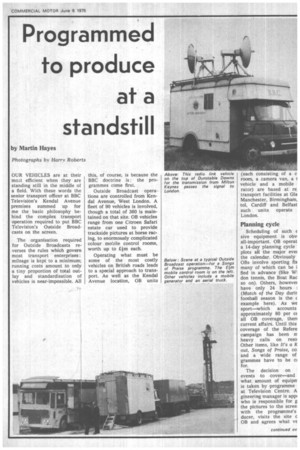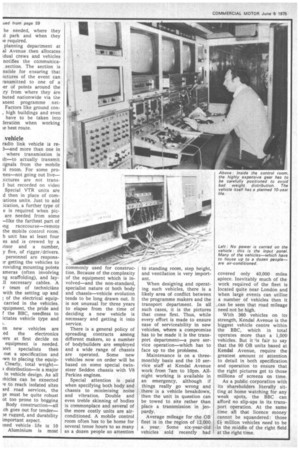Programmed to produce at a standstill
Page 63

Page 64

If you've noticed an error in this article please click here to report it so we can fix it.
by Martin Hayes
Photographs by Harry Roberts OUR VEHICLES are at their mo::t efficient when they are standing still in the middle of a field. With these words the senior transport officer at BBC Television's Kendal Avenue premises summed up for me the basic philosophy behind the complex transport operation required to put BBC Te!evision's Outside Broadcasts on the screen.
The organisation required for Outside Broadcasts reverses the rules which govern most transport enterprises: mileage is kept to a minimum; running costs amount •to only a tiny proportion of total outlay and standardisation of vehicles is near-impossible. All this, of course, is because the BBC doctrine is: the programmes come first.
Outside Broadcast operations are controlled from Kendal Avenue, West London. A fleet of 90 vehicles is involved, though a total of 360 is maintained on that site. OB vehicles range from one Citroen Safari estate car used to provide trackside pictures at horse racing, to enormously complicated colour mobile control rooms, worth up to Elm each.
Operating what must be some of the most costly vehicles on British roads leads to a special approach to transport. As well as the Kendal Avenue location, OB units (each consisting of a c room, a camera van, a I vehicle and a mobile rator) are based at re, transport facilities at Gla Manchester, Birmingham, tol, Cardiff and Belfast such units operate London.
Planning cycle
Scheduling of such E sive equipment is obv all-important. OB operat a 14-day planning cycle plots all the major evet the calendar. Obviously OBs involve sporting fix many of which can be i fled in advance (like Wi don tennis, the Boat Rac so on). Others, howevet have only 24 hours (Match of the Day durir football season is the c example here). As we sport—which accounts approximately 80 per CE all OB coverage, then current affairs. Until this coverage of the Refere campaign has been rr heavy calls on reso Other items, like It's a K out, Songs of Praise, co: and a wide range of grammes have to be for.
The decision on events to cover—and what amount of equipnis taken by .programme at Television Centre. A gineering manager is appi who is responsible for g the pictures to the scree: with the programme's ducer, visits the site c OB and agrees what ve be needed, where they d park and when they required.
planning department at al Avenue then allocates idual crews and vehicles notifies the communicasection. The section is nsible for ensuring that rictures of the event can :-ansmitted to one of a ,er of points around the Ty from where they are buted nationwide via the anent programme netFactors like ground con, high buildings and even have to be taken into leration when working le best route.
vehicle
radio link vehicle is reJ—and more than one in where transmission is tit—to actually transmit ;ignals from the mobile 31 room. For some proes—not going out live3ictures are not transbut recorded on video Special VTR units are d then in place of corn:ations units. Just to add ication, a further type Of e is required when pit. are needed from some —like the farthest part of Ing racecourse—remote the mobile control room. h unit has at least four es and is crewed by a visor and a number, y five, of rigger/drivers. personnel are respons)r getting the vehicles to roviding mounting points am eras (often involving ag scaffolding), and layII necessary cables. A r team of technicians with the setting up and ; of the electrical equipcarried in the vehicles. quipment, the pride and f the BBC, needless to ictates vehicle type and en new vehicles are ed the electronics !ers at first decide on equipment is needed. 3ort specialists theh out a specification and Nun to placing the equipClearly, total weight; distribution—is a major in vehicle design. As all ?hides can be expected Fe to reach isolated sites ard road services, the must be quite robust ot too prone to bogging Body construction—all ch goes out for tender3e rugged, and durability important aspect.
med vehicle life is 10 Aluminium is most commonly used for construction. Because of the complexity of the equipment which is involved—and the non-standard, specialist nature or both body and chassis—vehicle evolution tends to be long drawn out. It is not unusual for three years to elapse from the time of deciding a new vehicle is necessary and getting it into service.
There is a general policy of spreading contracts among different makers, so a number of bodybuilders are employed and a wide range of chassis are operated. Some new vehicles now on order will •be based on some special twinsteer Seddon chassis with V8 Perkins engines.
Special attention is paid when specifying both body and chassis to minimising noise and vibration. Double and even treble skinning of bodies is commonplace and several of the more costly units are airconditioned. A mobile control room often has to be home for several tense hours to as many as a dozen people so attention to standing room, step height, and ventilation is very important.
When designing and operating such vehicles, •there is a likely area of conflict between the programme makers and the transport department. In all such cases, it is the pictures that come first. Thus, while every effort is made to ensure ease of serviceability in new vehicles, where a compromise has to be made it is the transport department—a pure service operation—which has to face up to the problems.
Maintenance is on a threemonthly basis and the 10 service staff at Kendal Avenue work from 7am to lOpm. Allnight working is available in an emergency, although if things really go wrong and there is a vehicle breakdown, then the unit in question can be towed to site rather than place a transmission in jeopardy.
Average mileage for the OB fleet is in the region of 12,000 a year. Some six-year-old vehicles sold recently had covered only 40,000 miles apiece. Inevitably much of the work required of the fleet is located quite near London and when large events can utilise a number of vehicles then it ,can be seen that road mileage need not be high.
With 360 vehicles on its strength, Kendal Avenue is the biggest vehicle centre within the BBC, which in total operates more than a 1,000 vehicles. But it -is fair to say that the 90 OB units based at Kendal Avenue, require the greatest amount or attention to detail in both specification and operation to ensure that the right pictures get to those millions of screens on time.
As a public corporation with its shareholders literally sitting at home watching for any weak spots, the BBC can afford no slip-ups in its transport operation. At the same time all that licence money cannot be squandered: those £4 million vehicles need to be .in the middle of the right field at the right time.


















































































































